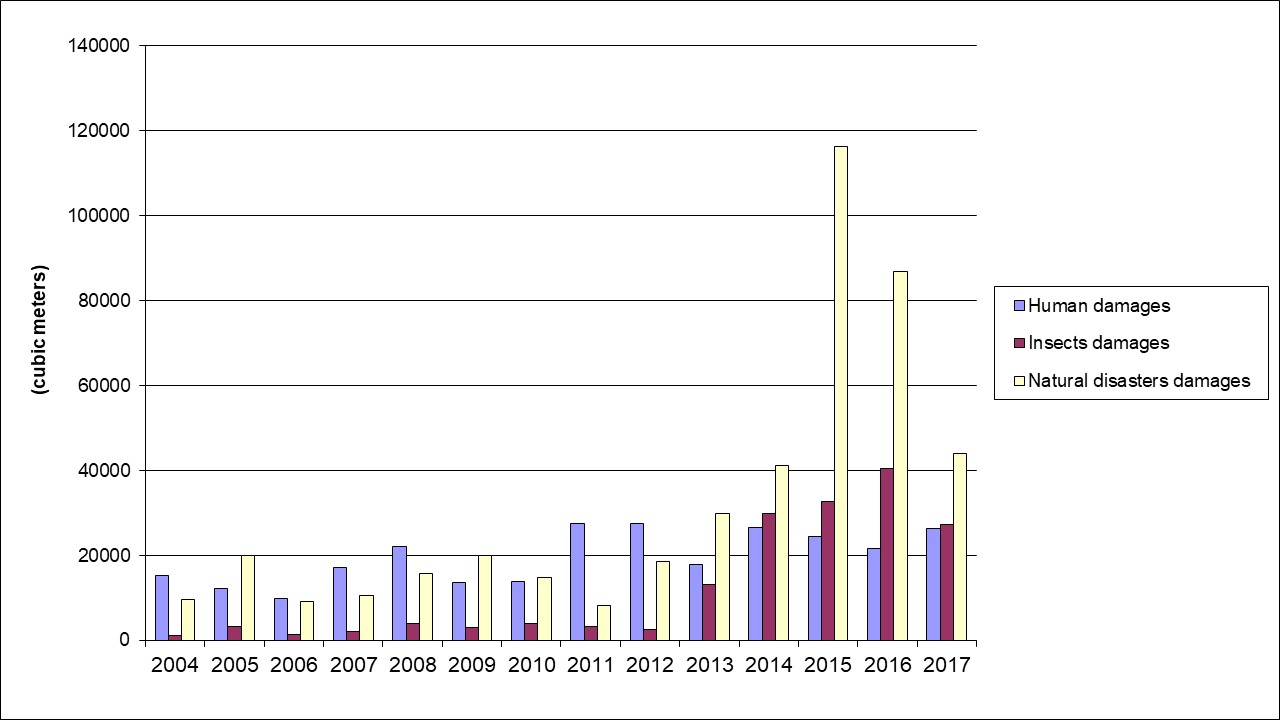Key message: Increase in damage from natural disasters and insects
Assessment: The indicator shows level of damage to the forests, broken down by selected biotic, abiotic and anthropogenic agents. The indicator is used to express level of damages and to compare which agent has the most expressive effect. In 2011 and 2012 man-made damage was the most expressed, while in recent year damage caused but natural disasters increased several times. Agents causing damage to the forests are biotic, abiotic and anthropogenic. Biotic agents include insects and illnesses, wild animals and forest grazing cattle. Abiotic agents include fire, storm, wind, snow, drought, layers of mud and avalanche. Anthropogenic agents include illegal logging or other damage in forests caused by wood cutting, which leads to impaired health and vitality of forest ecosystems. During 2017 human damages in forest increased. Over 25,000 cubic meters of wood were illegally harvested, especially in the region of southern end eastern Serbia. Insects damages decreased for about 30% and natural disaster damages decreased for about 5%.
Picture: Damage to the forests broken down by agents
Indicator Name: Forest damages
Institution/Author: Environmental Protection Agency/Slaviša Popović
Use and interpretation:
The indicator shows damage registered in forests and other forest land, and / or wood volume on which damage is caused by the following agents: man, insect pests, natural disasters.
Key question(s) which indicator helps to answer
The indicator helps to answer two questions: Which agents cause higher damages in the forests? What is damage intensity?
Use of indicator
It was registered that agents causing damage to forests are biotic, abiotic and anthropogenic. The indicator show damage suffered by forests, broken down by selected biotic, abiotic and anthropogenic agents. The indicator is used to express level of damages and to compare which agent has the most expressive effect.
Scale of appropriate use
Forest damages are monitored every year in terms of three agents: man-made damages, insect pests, natural disasters and they are expressed in cubic meters. In 2011 and 2012, man-made damage was the most expressed, while in recent year damage caused by natural disasters increased several times.
Potential for aggregation:
Meaning of upward or downward trends („good or bad“)
During 2017, damages in forests presented in volume of trees were 121,000 m3. Damages caused by human are app. 26,000 m3, while damages caused as a result of natural disasters increased, 69 forest fires, were registered with damage of 6,000 m3. Damages caused by pests in state forests in 2017 are 17,000 m3.
Possible reasons for upward or downward trends:
It is evidenced that in last couple of years damage in forests caused by natural disasters started to be most intensive than in previous period, before 2013. In 2017 over 44,000 cubic meters of trees were destroyed by natural disasters, and it is around more than double lest damage than in previous 2016.
Man-made damage increased by about 20% in 2017, compared to 2016. The pressure on the forests was also maintained by intensive tourism and recreation activities which caused forest fires, pollution and destruction by air pollution, traffic or grazing cattle.
Implications for biodiversity management of change in the indicator:
The indicator is traditionally described in annual state of the environment reports in Serbia, and is determined as biodiversity indicator, according to The Rulebook on the National list of environmental protection indicators (Official Gazette of the Republic of Serbia No. 37/2011).
Units in which it is expressed:
The indicator is expressed in hectares (ha) or cubic meters (m3)
Description of source data:
Republic Statistical Office
Calculation procedure:
Methodology according to the criteria of ICP Forests, UNECE / FAO, DG Environment. Methodology defined by the Republic Statistical Office.
Most effective forms of presentation:
(graph types, maps, narratives, etc.-give examples where possible):
The best way to present this indicator is a graph.
Limits to usefulness and accuracy:
The data are obtained by the complete coverage of the reporting units of the Statistical Office. The accuracy of the data can be assessed as satisfactory. Precision depends exclusively on the delivery of data by all forest users.
(e.g. slow change in response to pressures, poor quality data, limited scope for updating)
Updating the indicator:
Data are updated annually.
Closely related indicators
Forest fires
Additional information and comments
Table: Forest damages
Serbia